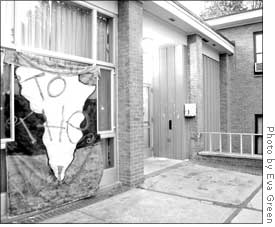
| << Front page | News | October 7, 2005 |
Afrikan Heritage House protest yields results
Students take their demands to Dye and
Tyson
 |
||
| Afrikan Heritage: The exterior of Lord-Saunders, home of Afrikan Heritage House, where residents have been pushing for a full renovation inside and out. | ||
The drain drama at Lord-Saunders is slowly coming to a potential resolution after the damaged carpet from the rooms in which a pipe broke on Sept. 18 is finally being replaced. This is in response to last Friday’s protest by Afrikan Heritage House residents, who went all over campus chanting “Hey-hey, ho-ho, that sewage carpet’s got to go!”
At noon last Friday, a group of about 50 students stormed ResEd looking for answers to why the carpet that had been soaked with “gray water” was still not replaced, despite their requests. They were told by Molly Tyson, associate dean of students and director of Residential Education and Dining Services, that every year ResEd can only fix one dorm due to budgetary restraints and last year no dorms were fixed because of the financial crisis.
“[Molly Tyson said that] there are ten dorms to consider. Harkness is one of them, Noah [is another], and they don’t know if the House will be fixed this year, but it is being evaluated,” said College junior Vanessa Flowers, an Afrikan Heritage House resident who was very vocal at the protest.
However, Flowers added, in 2002 both Third World House and Spanish House were fixed.
After visiting ResEd the group headed towards Cox where they intended on meeting with the President of the College Nancy Dye. Once in front of her office, they were told Dye was out of town.
“We are not gonna waste our precious time to talk to ears that are not here; we will go talk to the ears that are here,” said College junior Darryle Johnson.
Afterwards, the crowd moved toward Dascomb, carrying with them colorful posters that were turned into petitions.
“This is not a black protest, this might as well be your dorm,” said Johnson as he addressed the students sitting around the tables in Dascomb.
On the morning of the protest, ResEd had started cleaning and examining the carpet in question all over again.
“Today they started cleaning after [letting] it sit for a week,” said one of the residents of a room that was affected by the backed-up pipe.
“They said it is gray water, not sewage water, but I can smell the feces,” he continued. “My RA got sick after she got in there. I don’t know why we have to live like this. If that was their carpet it would have been moved by now and we all know it.”
Another one of the room’s residents shared that he had written a letter to Dye that same morning.
“Both my parents graduated in the ’70s, but things like this make you lose faith in the institution,” he said.
After the protest, immediate actions were taken to resolve the issues at hand.
“Even though our standard procedures had been followed and would not have indicated that the hallway and student room carpets needed to be replaced, the ongoing concerns of the students persuaded us that the replacement of these affected carpets would be helpful to the community,”
Tyson said. “We are currently in the process of working with the students in the three affected rooms to install the new flooring.”
The students who organized the protest, however, see it as the beginning of a series of changes.
“The protest kicked off what will be a continued address to the higher-ups of this institution that the House is falling apart, and we refuse to stand by and watch this important cultural center and campus resource fall into the cracks,” Johnson said.
He explained that the protest was organized by College sophomore and African Heritage House resident Eziwanyi Ukegbu, who was displeased about the “situation,” and decided to use this protest as a vehicle to promote change and open an even larger discussion concerning the current state of Afrikan Heritage House.
Johnson continued, “I felt that the protest was absolutely necessary in order to get the info out there and let it be known that we, as Afrikan Heritage House residents, will take it to the streets when it comes to our space and its preservation.
“The protest was not the only way to solve the problem, but I do feel it was the best way.”
Johnson added also that he doesn’t want to place blame on anyone.
“I understand the mechanics of bureaucracy, so I will not hold any one department or school office responsible —nor do I place any singular blame, but we will continue to fight on behalf of the House and to see that its future here on this campus is not only intact, but looked forward to with the honor and respect it deserves.”
Another issue that was brought up on the protest was the possibility that there is lead in the wallpaint, since the building has not been renovated in over 40 years.
“We are investigating the questions and concerns about lead paint,” Tyson said in response to these concerns.
“I have been researching the history of renovation projects across campus,” she continued. “I have been in contact with past staff of the Department of Res-Life to help in this process and ask for students to remain patient. I have learned that in 1992 the lounges, and between 1985 and 1989 the student rooms in Lord and Saunders were renovated. Both projects included new paint for the walls.”
As Student Senator Ozlem Gemici put it, “student voice has worked to
push a serious issue through the Oberlin bureaucracy.”
About us
Subscriptions
Advertising